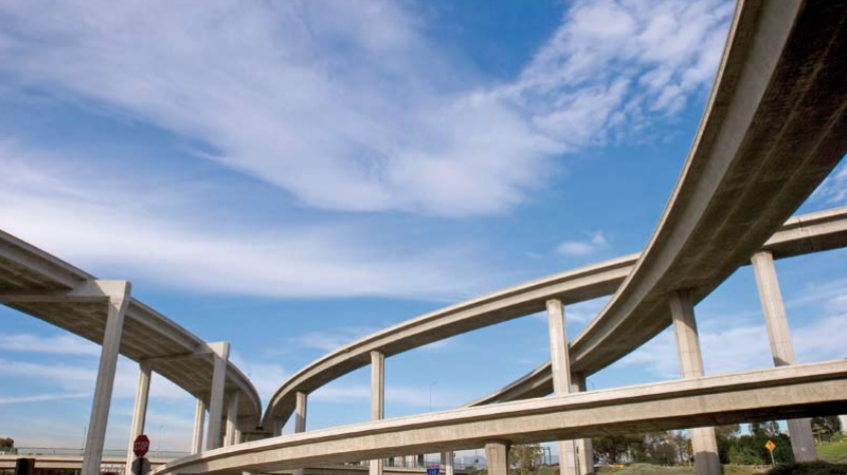
America’s Highway Spending Binge Goes On. And On. And On.
At a time when climate change threatens our future, the United States continues to spend four dollars expanding the highway network for every dollar it spends on expanding public transportation.

If you find yourself in a hole, the first step is to stop digging.
And if you are in a climate crisis, the first step toward solving it is to stop making it worse.
Transportation is Climate Enemy #1 in the United States. Thanks in part to persistently high consumption of gasoline and diesel fuel for our cars and trucks, America’s transportation system now produces more greenhouse gases than any other part of our economy – and more than the entire economies of all but three countries in the world (China, India and Russia).
Our heavy transportation carbon footprint is partly the result of massive capital investment we’ve made in expanding highways over the last century – coupled with relative disinvestment in public transportation. Those investment pattens have fueled sprawling, auto-oriented development across the country and made it nearly impossible for most Americans to get where they want to go by public transportation.
A recent federal report shows that that pattern of lavish investment in highway expansion continues. According to the U.S. Department of Transportation’s biennial(ish) report to Congress on the state of our highways and transit systems, the nation spent $26 billion to expand the highway network in 2014, the last year for which data are available. In that year, one out of every four capital dollars spent on the highway network went to expansion – at a time when much of the existing highway network is aging and urgently in need of repair.
Meanwhile, the nation invested $6.4 billion on expanding transit systems in 2014. That’s right, at a time when climate change threatens our future, the United States continues to spend four dollars expanding the highway network for every dollar it spends on expanding public transportation.
A recent post by Yonah Freemark at the Transport Politic shows the results of those spending choices. Between 2010 and 2019, the nation added 1,200 miles of new and expanded transit service. That’s good. But over the same time period, the nation is on track to add roughly 28,500 lane-miles of new roads.
Despite changing demographics, evolving preferences and an increasingly urgent need to slash carbon pollution in every way we can, the nation still spends transportation money in much the same way we did in the late 20th century.
That’s not to say there haven’t been some changes, including a gradual reduction in spending on highway expansion and increase in transit spending over the last decade. In 2004, the nation spent nearly nine dollars on highway expansion for every dollar spent to expand transit (compared with today’s four-to-one ratio). And the share of highway spending going toward highway expansion in 2004 exceeded 37 percent, as opposed to about a quarter now.
Nevertheless, after more than a half century of explosive growth in road capacity and disinvestment in transit, the recent shift in funding priorities has not come even close to restoring a healthy balance of transportation options. At a time when every investment in fossil fuel infrastructure – whether it is a pipeline or a highway – needs to be evaluated by the standard of whether it helps us to zero out carbon emissions by 2050, that’s not nearly good enough.
It’s especially not good enough when many of those highway projects are of dubious value to the public in the first place. Our series of Highway Boondoggles reports (co-authored with U.S. PIRG Education Fund) has highlighted 50 highway projects across the country with questionable benefits – all of which have the potential to draw new cars to the roads and exacerbate climate change.
If all that weren’t bad enough, those road expansions are increasingly subsidized by the general tax revenue contributed by all of us, regardless of how much we drive. Americans often believe that roads “pay for themselves” through revenues from gas taxes, tolls and other vehicle charges. The recent U.S. DOT report shows (as we have in two previous reports) that that is simply not true. In 2014, less than half (44 percent) of all highway funding came from fees and taxes paid by motorists. We are not only digging ourselves a deeper hole in the fight against climate change, but those who can’t or choose not to drive are increasingly being stuck with the tab.
Politicians of both parties have been comfortable preserving the status quo – trading off higher spending on transit with more money for highways and vice versa – focusing on growing the infrastructure spending pie at a time when we really need to focus on reallocating the slices. Recent proposals to reauthorize the main federal transportation law, which expires later this year, are consistent with this history, including a marked increase in investment in measures to address climate change that is overwhelmed by an even larger increase in the amount of money devoted to highways.
The U.S. is due for a wholesale rethink of how and where we invest in transportation – not just to save the climate, but also to protect our health, reduce the waste of tax dollars, and build stronger communities. As is sometimes said of planting trees, the best time to have rethought our transportation spending priorities was 20 years ago. The second-best time is now.
Authors
Tony Dutzik
Associate Director and Senior Policy Analyst, Frontier Group
Tony Dutzik is associate director and senior policy analyst with Frontier Group. His research and ideas on climate, energy and transportation policy have helped shape public policy debates across the U.S., and have earned coverage in media outlets from the New York Times to National Public Radio. A former journalist, Tony lives and works in Boston.
